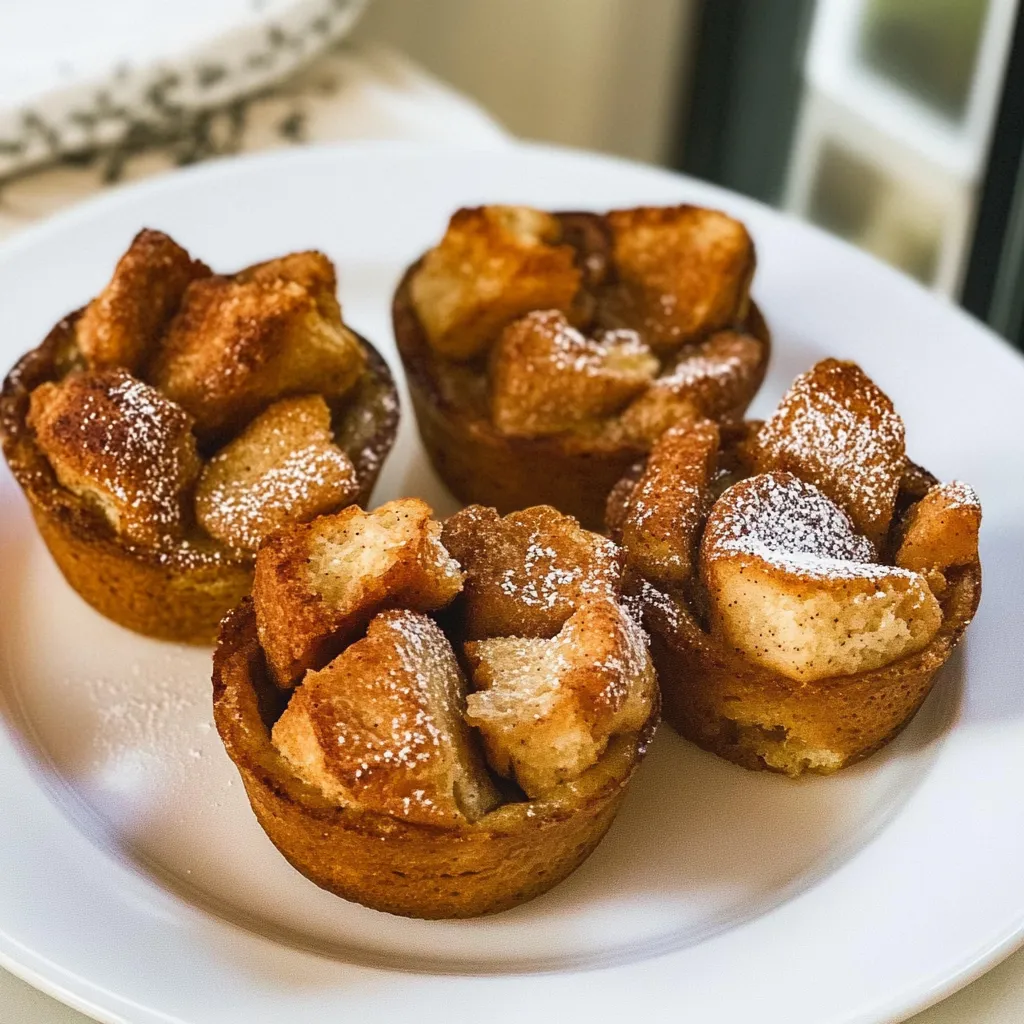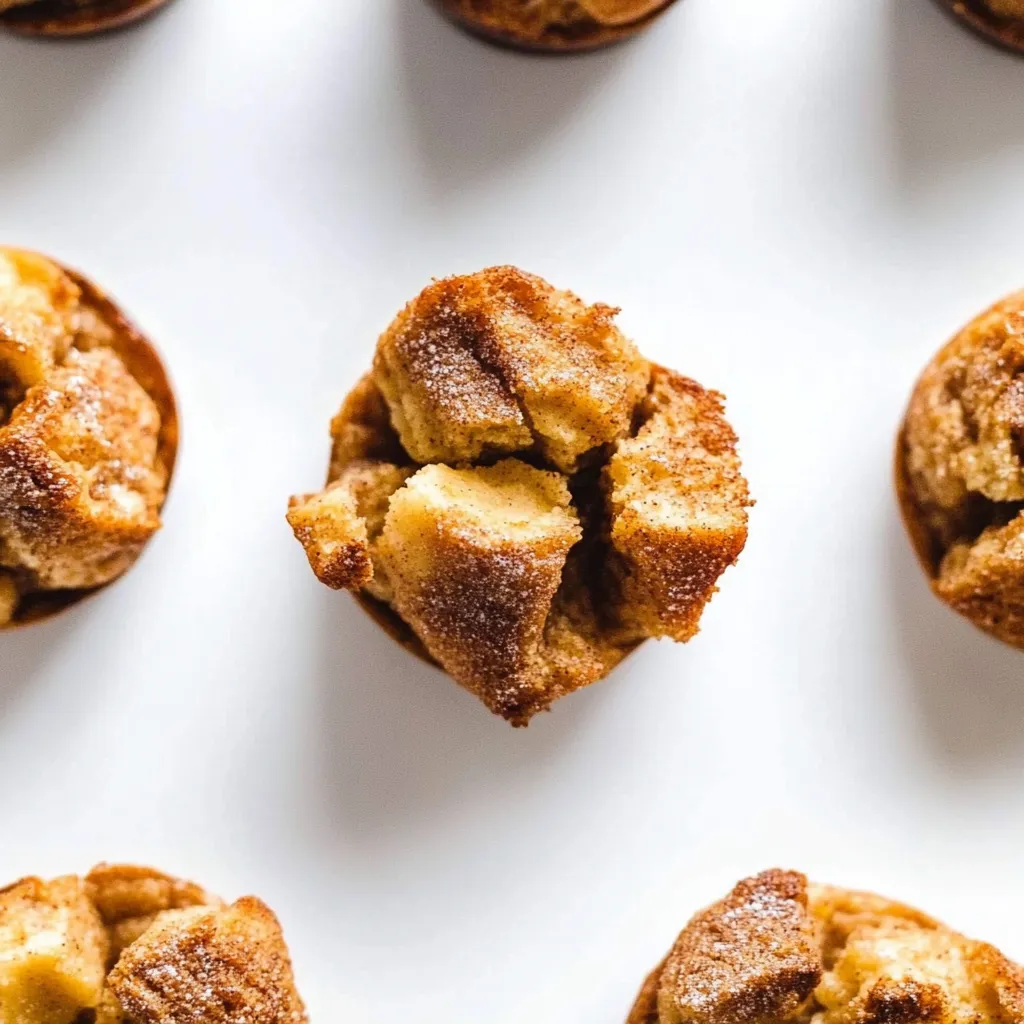 Pin it
Pin it
These French toast muffins transform your favorite weekend breakfast into a convenient grab-and-go treat that's perfect for busy mornings. Cubes of bread get soaked in a sweet custard mixture, then baked in muffin tins until golden and slightly crispy on the outside while staying tender inside. They capture all the cozy flavors of traditional French toast but in a portable format that's ideal for meal prep and kid-friendly breakfasts.
I created this recipe during a particularly hectic period when my mornings felt completely out of control. My kids were always rushing and never had time for a proper breakfast, but they'd beg for French toast on weekends. These muffins solved everything - I could make a batch on Sunday and have perfect breakfasts ready all week long. The first time I watched my daughter grab one from the container and happily eat it in the car, I knew I'd found our solution to chaotic mornings.
Essential Ingredients and Selection Tips
- Day-old bread: Slightly stale bread absorbs the custard better without becoming mushy; brioche, challah, or French bread work best
- Whole milk: Creates the richest, most tender texture; you can substitute but results will be less creamy
- Fresh eggs: Room temperature eggs blend more easily and create smoother custard base
- Pure maple syrup: Provides natural sweetness and authentic French toast flavor; avoid pancake syrup which tastes artificial
- Quality vanilla extract: Makes a noticeable difference in the final flavor; use pure extract, not imitation
- Fresh cinnamon: Ground cinnamon should smell fragrant and potent; replace if it's been sitting in your spice cabinet for over a year
Detailed Step-by-Step Instructions
- Prepare your workspace efficiently:
- Preheat your oven to 350°F and generously grease a 12-cup muffin tin with butter or cooking spray, making sure to coat the sides well to prevent sticking. Line with paper liners if preferred, though these muffins have a lovely golden crust when baked directly in greased tins. Have all ingredients measured and ready before you begin mixing.
- Create the perfect custard base:
- In a large mixing bowl, whisk together 1 cup whole milk, 3 large eggs, 1/4 cup maple syrup, and 1 teaspoon vanilla extract until completely smooth and well combined. The mixture should be homogeneous with no streaks of egg visible. This custard base is what transforms ordinary bread into French toast magic.
- Prepare the bread properly:
- Cut 4-5 slices of day-old bread into 1/2-inch cubes, removing crusts if desired (though they add nice texture and color). You should have about 4 cups of bread cubes. If your bread is fresh, lightly toast the cubes for 5 minutes in a 300°F oven to remove some moisture, then let cool before proceeding.
- Combine and soak thoroughly:
- Add the bread cubes and 1 teaspoon ground cinnamon to the custard mixture, gently folding everything together until all bread pieces are coated. Let this mixture sit for 10-15 minutes, stirring occasionally, to allow the bread to fully absorb the custard. The bread should look saturated but not completely falling apart.
- Fill muffin cups generously:
- Using a large spoon or ice cream scoop, divide the soaked bread mixture evenly among the prepared muffin cups, filling each nearly to the top. Press down gently to pack the mixture slightly, but don't compress it too much as you want some texture and air pockets for the best final result.
- Bake to golden perfection:
- Bake for 25-30 minutes, until the tops are golden brown and the centers feel firm when lightly pressed. The muffins should have risen slightly and developed a beautiful golden crust. If the tops are browning too quickly, tent with foil for the last 5-10 minutes of baking.
- Cool properly for best texture:
- Let the muffins cool in the pan for 5 minutes to firm up, then carefully run a knife around the edges and turn them out onto a wire cooling rack. This brief cooling period prevents them from falling apart while still allowing them to release easily from the pan.
- Add optional finishing touches:
- While still slightly warm, brush the tops with melted butter and sprinkle with cinnamon sugar for extra sweetness and crunch. This step is optional but adds that authentic French toast experience and makes them look bakery-professional.
 Pin it
Pin it
The transformation these muffins brought to our morning routine was incredible. Instead of the usual breakfast battles, my kids actually looked forward to grabbing their French toast muffin and heading out the door. I love how they taste like a special weekend treat but require so little effort during the week. Even my husband, who's usually not a breakfast person, started taking them to work after trying one warm from the oven.
Understanding Custard-to-Bread Ratios
The success of French toast muffins depends on the proper balance between custard and bread. Too much liquid creates soggy, fallen muffins, while too little results in dry, bread pudding-like texture. The bread should absorb most of the custard while maintaining some structure, creating that perfect tender-yet-structured final product.
Bread Selection and Preparation
Different breads create vastly different results. Enriched breads like brioche and challah contain eggs and butter that enhance the custard effect, while sturdy breads like French bread provide better structure. Day-old bread has lost enough moisture to absorb the custard without becoming mushy, which fresh bread cannot achieve.
Baking Chemistry and Texture Development
During baking, the eggs in the custard coagulate and set the structure while the milk creates steam that keeps the interior tender. The direct contact with the hot muffin tin creates the golden, slightly crispy exterior that mimics the best parts of traditional French toast. This dual texture is what makes these muffins so satisfying.
Make-Ahead and Storage Strategies
These muffins actually improve in flavor after sitting overnight as the bread and custard flavors meld completely. They freeze exceptionally well because the custard base prevents ice crystal formation that would make them soggy. Proper cooling before storage prevents condensation that would ruin the texture.
Customization Without Compromising Structure
Add-ins work best when they don't add excess moisture or interfere with the custard's ability to set properly. Fresh berries should be patted dry, while dried fruits and nuts can be added generously. Chocolate chips work well because they hold their shape during baking and add richness without moisture.
These muffins represent everything I love about practical cooking - they solve a real problem while delivering genuine pleasure and satisfaction. The fact that they taste like an indulgent weekend breakfast but fit seamlessly into busy weekday routines makes them invaluable for any family trying to balance nutrition, convenience, and happiness in their morning routine.
Frequently Asked Questions
- → Can I use regular milk instead of almond milk?
- Yes, you can substitute regular milk, oat milk, or any milk you prefer. The taste will be slightly richer with dairy milk.
- → What type of bread works best for these muffins?
- Day-old sourdough, challah, or brioche work perfectly. Stale bread absorbs the custard better without getting mushy.
- → How long do these muffins stay fresh?
- Store them in the fridge for up to 5 days or freeze for up to 3 months. Reheat in the microwave for 30 seconds before serving.
- → Can I make these muffins ahead of time?
- Yes! You can prep the mixture the night before and bake in the morning, or bake them completely and reheat when ready to eat.
- → Do I need the cinnamon sugar topping?
- The topping is optional but adds a nice sweet crunch. You can skip it or use powdered sugar instead for a different flavor.
- → Why do I need to let the bread soak?
- Soaking for 10-15 minutes lets the bread fully absorb the custard mixture, which creates the perfect French toast texture when baked.
